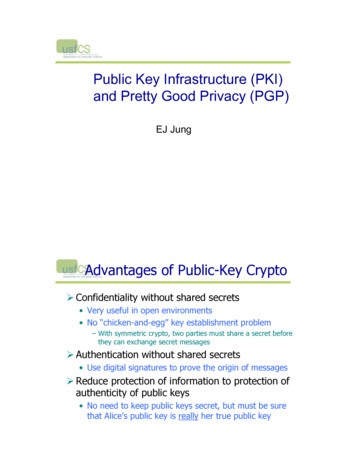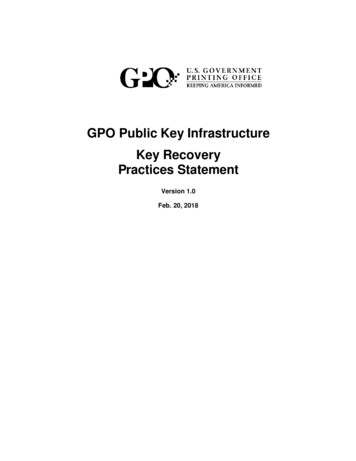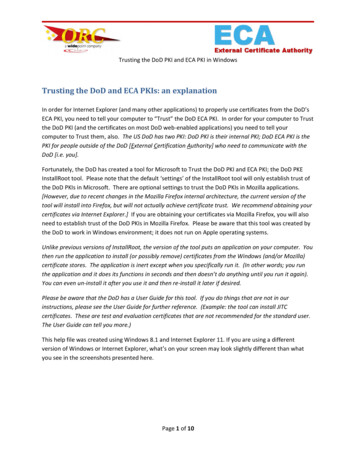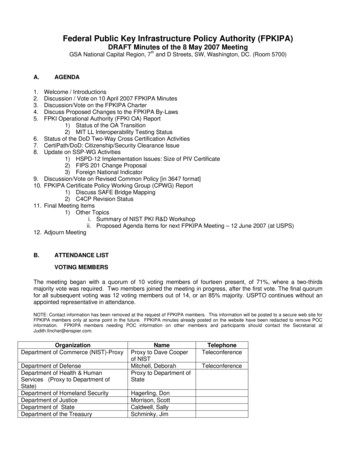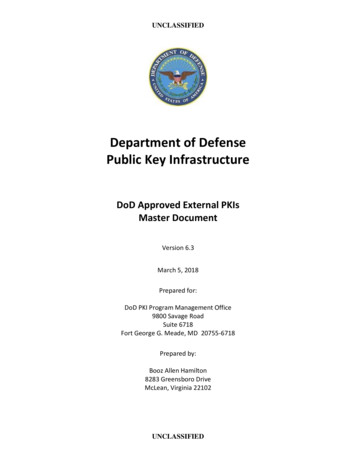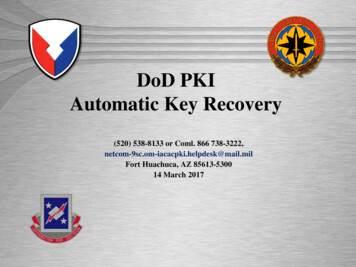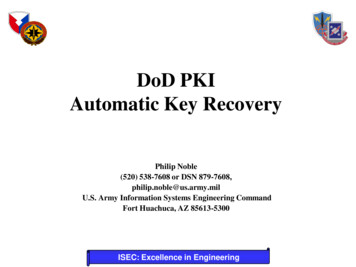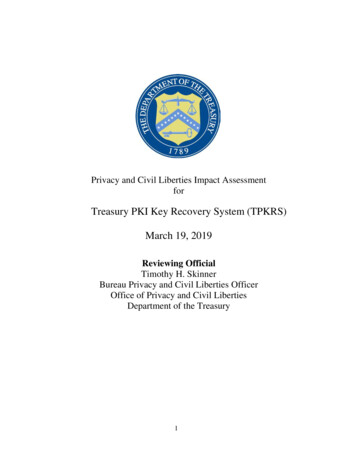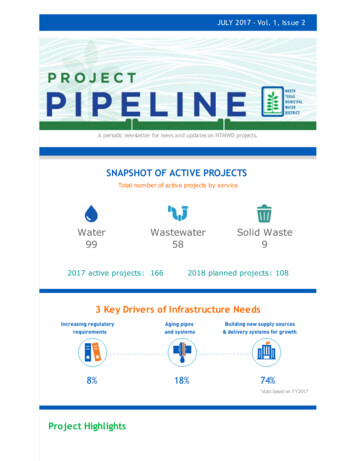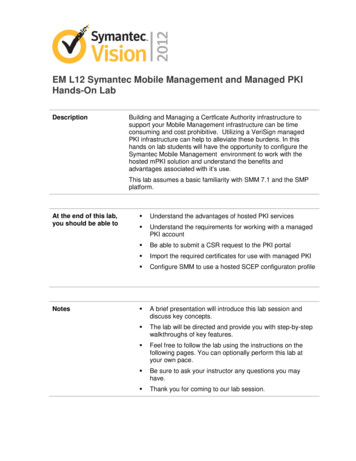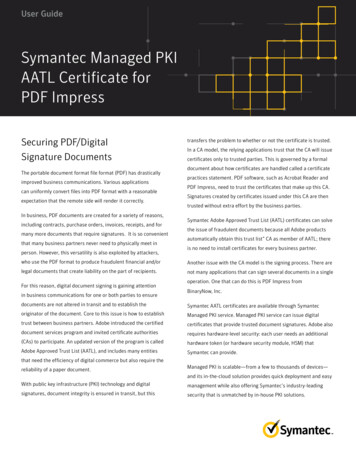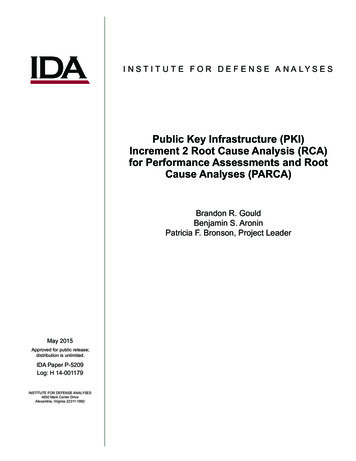
Transcription
I N S T I T U T E F O R D E F E N S E A N A LYS E SPublic Key Infrastructure (PKI)Increment 2 Root Cause Analysis (RCA)for Performance Assessments and RootCause Analyses (PARCA)Brandon R. GouldBenjamin S. AroninPatricia F. Bronson, Project LeaderMay 2015Approved for public release;distribution is unlimited.IDA Paper P-5209Log: H 14-001179INSTITUTE FOR DEFENSE ANALYSES4850 Mark Center DriveAlexandria, Virginia 22311-1882
The Institute for Defense Analyses is a non-profit corporation that operatesthree federally funded research and development centers to provide objectiveanalyses of national security issues, particularly those requiring scientific andtechnical expertise, and conduct related research on other national challenges.About This PublicationThis work was conducted by the Institute for Defense Analyses (IDA) undercontract HQ0034-14-D-0001, Project AY-7-357815, “Root Cause Analysis andPerformance Assessment Methods and Analyses (Public Key Infrastructure),” forthe Director, Performance Assessments and Root Cause Analyses. The views,opinions, and findings should not be construed as representing the officialposition of either the Department of Defense or the sponsoring organization.AcknowledgmentsThank you to Lawrence N. Goeller, Stanley A. Horowitz, and Shanti Satyapal forperforming technical review of this document.Copyright Notice 2014, 2015 Institute for Defense Analyses4850 Mark Center Drive, Alexandria, Virginia 22311-1882 (703) 845-2000.This material may be reproduced by or for the U.S. Government pursuant tohe copyright license under the clause at DFARS 252.227-7013 (a)(16) [Jun 2013].
I N S T I T U T E F O R D E F E N S E A N A LYS E SIDA Paper P-5209Public Key Infrastructure (PKI)Increment 2 Root Cause Analysis (RCA)for Performance Assessments and RootCause Analyses (PARCA)Brandon R. GouldBenjamin S. AroninPatricia F. Bronson, Project Leader
Executive SummaryThe Public Key Infrastructure (PKI) program is a Department of Defense (DoD)Major Automated Information System (MAIS) acquisition effort. “PKI” refers to theframework and services that provide for the generation, production, distribution, control,revocation, recovery, and tracking of Public Key certificates, and their correspondingprivate keys. PKI certificates provide the Information Assurance (IA) that enablesCommercial-off-the-Shelf (COTS) and Government-off-the-Shelf (GOTS) applications tosecurely perform their e-business functions.On October 31, 2013, the National Security Agency (NSA) Senior AcquisitionExecutive (SAE) declared a Critical Change to the PKI Increment 2 program. (A CriticalChange for an MAIS program is analogous to a Critical Nunn-McCurdy Breach for aMajor Defense Acquisition Program.) NSA provided two reasons for issuing this criticalchange: Inability to achieve PKI Increment 2 Full Deployment Decision (FDD) withinfive years of program initiation (March 1, 2014 deadline), and Delay of over one year in the original FDD estimate provided to the Congress (1March 2014 deadline).The proximate cause of the Critical Change, reported in the DoD PKI CriticalChange Executive Leadership Update dated December 18, 2013, was that “Initial andFollow-on Operational Test and Evaluations resulted in not operationally suitable and notoperationally effective ratings that were not resolved in time to support a 1 March 2014FDD.”The Director, Performance Assessments and Root Cause Analyses (PARCA), askedthe Institute for Defense Analyses (IDA) to conduct an RCA on the PKI Increment 2Critical Change. This paper summarizes IDA’s understanding of the problem, ourmethodology, and our findings.IDA concludes that the root cause of the Critical Change in the PKI Increment 2program is the lack of understanding, from the beginning of the program, of the scope ofthe work that needed to be done to track and manage the Secure Internet Protocol RouterNetwork (SIPRNet) tokens. We attribute this lack of understanding to poor performanceby government personnel. From the beginning, the Services and Agencies (S/As),Program Executive Office (PEO), Program Management Office (PMO),1 and IdentityProtection and Management Senior Coordinating Group (IPMSCG) should haveiii
understood the scope of the requirement, but did not. Once the problems becameapparent, these organizations did not find and fix them in a timely fashion.The IDA team also found there were unrealistic estimates for cost and schedule, theroot cause of which was also a lack of understanding of the scope of work. Substantialwork associated with Spiral 2 (Tactical) and Spiral 3 (Enhanced Status Quo) was deferredto later increments and are not part of this Critical Change. Additional resources will beneeded to complete the deferred and unmet scope of work from Increment 2, but that willbe for a future increment and will likely not be treated as a Critical Change for Increment2.We believe that the MAIS process itself is a contributor to this Critical Change. Wedo not believe the best resource planning can be accomplished in an environment inwhich the user decides the content of a program that has a fixed five-year developmentcycle. For this strategy to succeed, the user must develop and maintain a resource-loadedschedule for every item on their list of priorities. Each item has to be described wellenough to demonstrate that the requirements are understood, and each item must have acost estimate based on those requirements. We did not find evidence of well-documentedresource-loaded schedules in the documentation we examined (including AcquisitionStrategy, Systems Engineering Plan, or Life Cycle Cost Estimate Summary) for the PKIeffort.1PMO includes both program management and systems engineering functions.iv
Contents1.2.3.Introduction .1Methodology.3PKI Increment 2 System Description .5A. Description from the MAR.5B. High Level Description of the Capabilities from the Systems EngineeringPlan .61. SIPRNet Expansion .62. Tactical Environments .63. Homeland Security Presidential Directive (HSPD) 12 .74. Enhancing the Status Quo Capabilities .7C. Management Structure and Roles and Responsibilities .84. Description of the Critical Change .115. Proximate Causes for Schedule Growth .136. Timeline Leading Up to the Critical Change .15A. 2008 .15B. 2009 .16C. 2010 .16D. 2011 .16E. 2012 .17F. 2013 .187. Root Cause Narrative .19A. Logistics Shortfalls and Missing ILS Functionality .19B. Configuration Management .21C. Token Reliability Issues .22D. Priority toward Token Issuance .23E. Failing to Meet the Requirements .24F. Deferral of Requirements .26G. WSARA 2009 Root Cause Categories .278. Root Cause Analysis.31A. Lack of Understanding of the Logistics Support Requirement .31B. Faulty Baseline .34C. Oversight .359. Conclusions .39Appendix A. DoD CIO Issuance Mandate October 14, 2011. A-1Appendix B. Full Fielding ADM Jan 2012 .B-1v
Illustrations .C-1References . D-1Abbreviations . E-1vi
1.IntroductionThe Director, Performance Assessments and Root Cause Analyses (PARCA), isresponsible for conducting root cause analyses (RCAs) for Major Defense AcquisitionPrograms (MDAPs) when required by the Weapon Systems Acquisition Reform Act(WSARA) of 20091 or when requested by the Secretary of Defense, the Under Secretary ofDefense for Acquisition, Technology and Logistics (USD(AT&L)), the Secretary of amilitary department, or the head of a Defense Agency.2PARCA requested that the Institute for Defense Analyses (IDA) conduct a rootcause analysis of the PKI Increment 2 program based on the 31 October 2013 CriticalChange declared by the National Security Agency (NSA) Senior Acquisition Executive(SAE). This was a discretionary RCA for PARCA. This paper summarizes IDA’sunderstanding of the problem, our methodology, and our findings.Chapter 2 presents IDA’s methodology for conducting RCAs for PARCA. Chapter3 contains the Program Description for Public Key Infrastructure (PKI) Increment 2 fromthe Major Automated Information System (MAIS) Annual Report (MAR) of December2013. Chapter 4 provides the official description of the Critical Change. Chapter 5 reportsreasons for the breach as provided by the Program Management Office (PMO), theProgram Executive Office (PEO) or other stakeholders. Chapter 6 provides the timelineof events leading up to the critical change. Chapter 7 starts with the Critical Change andworks backwards, identifying its root causes aligned with WSARA taxonomy. Chapter 8provides IDA’s findings on the root causes of the PKI Increment 2 Critical Change andother findings. Chapter 9 provides IDA’s conclusions on the root cause of the CriticalChange for the PKI Increment 2 program.12Weapon Systems Acquisition Reform Act, Pub. L. 111-23, 123 Stat. 1704 (2009), § 103(b)(2).Ibid., § 103(b)(1).1
2.MethodologyPKI Increment 2 is a MAIS. A Critical Change for an MAIS program is analogousto a critical Nunn-McCurdy breach for an MDAP. Accordingly, IDA’s methodology forPKI Increment 2’s Critical Change is identical to that of an MDAP experiencing a criticalNunn-McCurdy breach.The methodology is composed of an official statement of the critical change,proximate causes for the Critical Change, a timeline of events leading up to the CriticalChange, a root cause narrative that works backward from the Critical Change, andidentification of root causes of the Critical Change.The official statement of the breach is recorded in a program deviation report fromthe SAE to the Milestone Decision Authority (MDA). It is also recorded in the MAR.The MAR documents the Critical Change and includes the program office’s position onthe Critical Change and its causes in the Executive Summary.The timeline of events identifies the important events leading up to the breach. TheIDA research team constructs the initial version of the timeline from the program’shistorical MARs, but all sources are considered for the timeline of events leading up tothe breach.The Root Cause Narrative is a method for classifying the events identified in the“Timeline of Events” according to the WSARA root cause categories. WSARA providesseven specific root causes, but does not exclude the possibility that there may be others.The WSARA categories are: Unrealistic performance expectations Unrealistic baseline estimates for cost or schedule Immature technologies or excessive manufacturing or integration risk Unanticipated design, engineering, manufacturing, or technology integrationissues arising during program performance Changes in procurement quantities Inadequate program funding or funding instability Poor performance by government or contractor personnel responsible forprogram management Any other matters3
The Root Cause Narrative begins with the statement of the breach and proceedsbackward in time, linking contributing factors. Ultimately, the contributing factors areclassified as symptoms; proximate causes; root causes; and factors unrelated to cost orschedule growth. Graphs and data (as opposed to bullets and text) are provided asevidence without comment and conclusion. The evidence stands by itself and each readeris free to infer his or her own meaning.The Root Cause Analysis identifies the root causes and allocates the contributingfactors from the root cause narrative to these root causes. The root cause analysis alsoaddresses whether the root causes reflect inception or execution problems anddistinguishes between root causes that are exogenous and endogenous to the program.4
3.PKI Increment 2 System DescriptionFigure 1 is the PKI logo taken from the 2013 MAR.Figure 1. Department of Defense (DoD) PKI ProgramA. Description from the MARPublic Key Infrastructure (PKI) refers to the framework and services thatprovide for the generation, production, distribution, control, revocation,recovery, and tracking of Public Key certificates and their correspondingprivate keys and enabling Commercial Off the Shelf and Government Offthe Shelf applications that provide Information Assurance and e-businesscapabilities. PKI will issue and manage electronic/digital identities andassociated credentials and key materials for users, applications, servers,and network components.The DoD PKI, Increment 2 was baselined to complete three developmentspirals to be implemented from FY 2009 through FY 2014. Increment 2initiatives include the use of a hardware token on Secure Internet ProtocolRouter Network (SIPRNet), expansion of PKI into tactical low-bandwidthconstrained environments, and compliance with Homeland SecurityPresidential Directive 12. The Program received a Milestone B Decisionin April 2009 to enter the Engineering and Manufacturing Developmentphase.The Program achieved a Milestone C decision in February 2011 to enterinto Initial Operational Test and Evaluation (IOT&E) for Spirals 1 and 2.The Program completed IOT&E in September 2011 and declared InitialOperational Capability in November 2011. The Program achieved aFielding Decision for Spiral 1 (SIPRNet) and Spiral 2 (Tactical) in5
January 2012. Spiral 3 (Enhanced Status Quo) of the DoD PKI Program isin development.3B. High Level Description of the Capabilities from the SystemsEngineering PlanThe DoD PKI refers to the core framework and services that provide for thegeneration, production, distribution, control, revocation, recovery, storage, destruction,and accounting of public and private key certificates.DoD PKI system components include Certificate Authorities (CAs) and a certificaterepository; documentation, including a Certificate Policy document; CertificationPractice Statements; and trained personnel performing trusted roles to operate andmaintain the system. The DoD PKI framework is designed to provide the criticallyneeded support for a broad range of human and Non Person Entities (NPEs) (e.g.,applications, network devices, processes, etc.).DoD PKI enables secure encryption, authentication of network transactions, dataintegrity, and non-repudiation to a broad range of government- and commercially based,security-enabled applications. DoD PKI supports the DoD’s Defense-in-Depth layeredInformation Assurance (IA) strategy and provides for secure interoperability within DoDand with its Federal, Coalition, Allied partners and Non-Government Organizations.The following paragraphs provide a high-level description of the four capabilitiesprovided by DoD PKI Increment Two. These descriptions are from Increment 2’sSystems Engineering Plan (SEP).1.SIPRNet ExpansionThe Increment Two SIPRNet expansion will provide support for the issuance ofhardware tokens to support all SIPRNet users. In addition to providing support for ahardware token, the Increment Two SIPRNet expansion will provide support forinteroperability between DoD SIPRNet users and Federal, State, and Coalition Partnersand Allies in compatible environments. Finally, to maintain parity between the SIPRNetand Non-secure Internet Protocol Router Network (NIPRNet) PKI implementations, anyenhancements integrated into the NIPRNet PKI implementation as a result of IncrementTwo will also be incorporated into the SIPRNet infrastructure.2.Tactical EnvironmentsThe DoD PKI must be able to provide CA services that support certificatemanagement, issuance, revocation, suspension, restoration, and validation in Tactical3Program Description for PKI Increment 2 from MAR, December 2013.6
environments. Four development activities were identified to meet the requirements forexpansion of the DoD PKI into Tactical environments:3. Deployed Certificate Authority (DCA)4 Tactical Registration Authority (TRA)5 Alternative token form factors6 Joint Tactical IA Concept of Operations (CONOPS)Homeland Security Presidential Directive (HSPD) 12The following describes the HSPD-12 solution:4. Establish an Interoperability Root CA to support HSPD-12 requirement toparticipate with Federal Bridge Certificate Authority (FBCA)/ common policyObject Identifiers (OIDs). Transition to Server-based Certificate Validation Protocol (SCVP) utilizingexisting Online Certificate Status Protocol (OCSP) Infrastructure. Transition PKI Infrastructure to support Personal Identity Verification (PIV)Authentication Certificates. Implement Rivest, Shamir, and Adelman (RSA) 2048 when viable and transitionto Secure Hash Algorithm (SHA)-256 and/or Suite B (Elliptic CurveCryptography [ECC] & SHA) when systems and applications ubiquitouslysupport ECC & SHA-256.Enhancing the Status Quo CapabilitiesThe Enhanced Status Quo architecture will provide the means to establishcentralized trust and visibility of all aspects of the DoD enterprise to include the fullscope of auto-enrollment and auto-renewal services as required by the enterprise. Thisincludes support for, but is not limited to, all certificates issued, various protocols (i.e.,Simplified Certificate Enrollment Protocol [SCEP]) and applications fielded in Do
The Public Key Infrastructure (PKI) program is a Department of Defense (DoD) Major Automated Information System (MAIS) acquisition effort. “PKI” refers to the framework and services that provide for the generation, production, distribution, control, revocation, recovery, and tra
